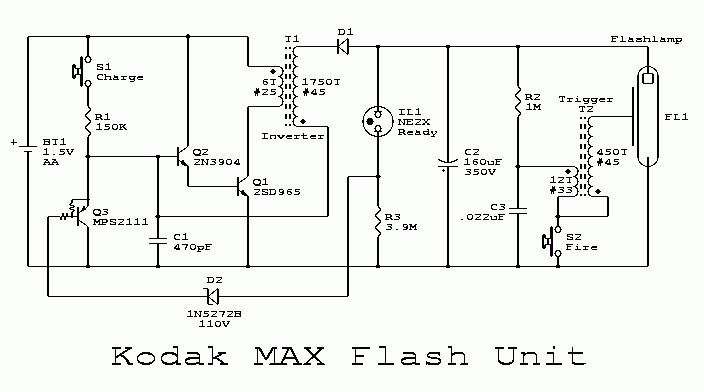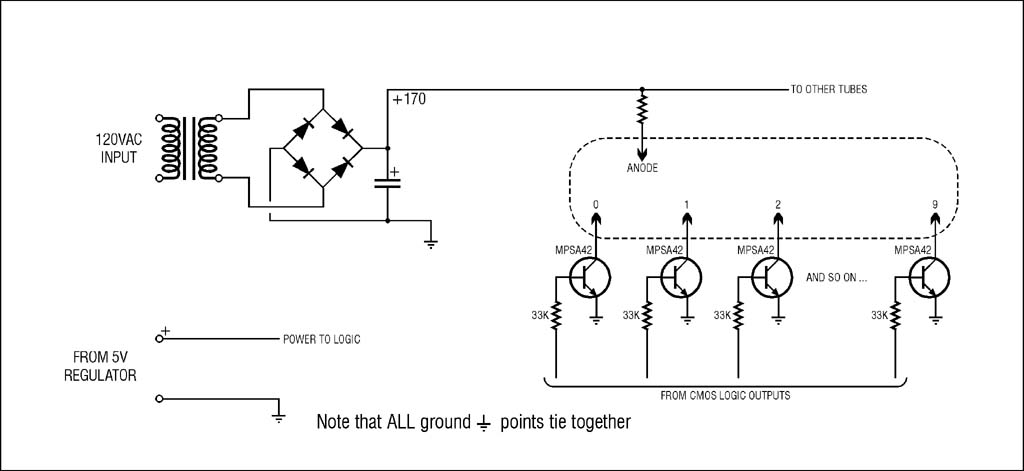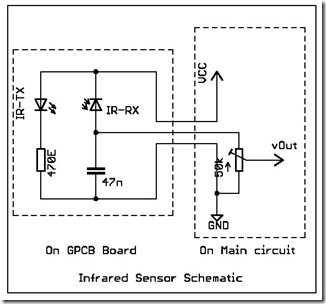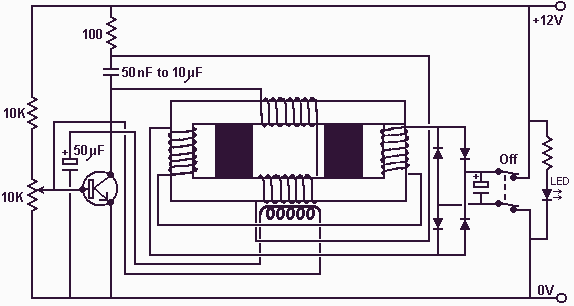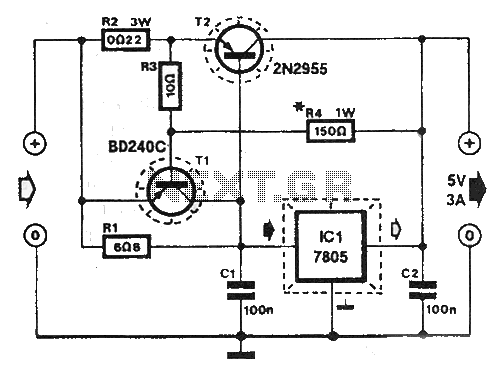
Regulator Circuit

The unique feature of this regulator is that the output voltage can be adjusted down to 0 V. The regulation is provided by an integrated regulator type LM317. Typically, in supplies that can be adjusted to 0 V, this IC is used in conjunction with a zener diode. This diode supplies a reference voltage that is equal but of opposite sign to the reference voltage (Uref) of the regulator, as illustrated in Figure 74-1 (a). A potential divider consisting of resistors R1 and R2 allows for the adjustment of the output voltage. In this circuit, the negative reference voltage is derived differently: from the regulator using an operational amplifier (op amp) as shown in Figure 74-1 (b). The op amp is configured as a differential amplifier that measures the voltage across resistor R1 and inverts this voltage to the reference voltage (Ur). An additional advantage of this configuration is that at low output voltages, variations in the reference voltage have a lesser impact on the output voltage compared to the circuit in Figure 74-1 (a). The prototype, constructed as depicted in Figure 74-1 (c), yielded very satisfactory results. The op amp does not require any special specifications; a 741 op amp performs adequately, although an LF356 offers slightly improved performance. The negative supply for the op amp can be obtained using a center-tapped mains transformer.
The circuit described utilizes the LM317 adjustable voltage regulator, which is capable of outputting voltages from 1.25 V up to 37 V, with the added capability of reaching 0 V through the use of a zener diode and an op amp configuration. The zener diode serves to establish a stable reference voltage, which is essential for the accurate regulation of the output voltage. In the traditional setup (as shown in Figure 74-1 (a)), the zener diode directly influences the reference voltage of the LM317, providing a negative feedback loop that stabilizes the output.
In the alternative configuration (Figure 74-1 (b)), the operational amplifier is employed to enhance performance, particularly in low-voltage applications. This configuration allows for more precise control over the output voltage by measuring the voltage drop across resistor R1 and inverting this signal to create a negative reference voltage. The differential amplifier setup ensures that any fluctuations in the reference voltage have a minimized effect on the output, which is particularly beneficial when operating at lower voltages.
The choice of op amp can influence circuit performance; while a standard 741 op amp suffices for basic applications, the LF356 offers enhanced bandwidth and lower noise characteristics, which can be advantageous in precision applications. The design also incorporates a center-tapped mains transformer to provide the necessary negative supply voltage for the op amp, ensuring that the circuit operates effectively across its intended voltage range.
Overall, this circuit design exemplifies a robust solution for applications requiring adjustable voltage regulation down to 0 V, combining the reliability of the LM317 with the precision of an op amp in a differential configuration. The prototype results indicate that this approach is effective, making it suitable for a variety of electronic applications where precise voltage regulation is required. The special characteristic of this regulator is that the output voltage can be adjusted down to 0 V. The regulation is pr ovided by an integrated regulator Type LM317. As is normal in supplies that can be adjusted to 0 V, this IC is used in conjunction with a zener diode. This diode provides a reference voltage that is equal, but of opposite sign, to the reference voltage (U,) of the regulator, as shown in Fig.
74-1 (a). Potential divider R1/R2 enables the output voltage to be adjusted. In this circuit, the negative reference voltage is derived in a different manner: from the regulator with the aid of an op amp (Fig. 74-1 (b)). The op amp is connected as a differential amplifier that measures the voltage across Rl and inverts this voltage to Ur.
An additional advantage of this method is that at low-output voltages, a change in the reference voltage has less effect on the output voltage than the circuit in Fig. 74-1 (a). The prototype, constructed as shown in Fig. 74-1 (c), gave very satisfactory results. The op amp need not meet any special requirements: a 741 works fine, although an LF356 gives a slightly better performance.
The negative supply for the op amp can be obtained with the aid of a center-tapped mains transformer.
The circuit described utilizes the LM317 adjustable voltage regulator, which is capable of outputting voltages from 1.25 V up to 37 V, with the added capability of reaching 0 V through the use of a zener diode and an op amp configuration. The zener diode serves to establish a stable reference voltage, which is essential for the accurate regulation of the output voltage. In the traditional setup (as shown in Figure 74-1 (a)), the zener diode directly influences the reference voltage of the LM317, providing a negative feedback loop that stabilizes the output.
In the alternative configuration (Figure 74-1 (b)), the operational amplifier is employed to enhance performance, particularly in low-voltage applications. This configuration allows for more precise control over the output voltage by measuring the voltage drop across resistor R1 and inverting this signal to create a negative reference voltage. The differential amplifier setup ensures that any fluctuations in the reference voltage have a minimized effect on the output, which is particularly beneficial when operating at lower voltages.
The choice of op amp can influence circuit performance; while a standard 741 op amp suffices for basic applications, the LF356 offers enhanced bandwidth and lower noise characteristics, which can be advantageous in precision applications. The design also incorporates a center-tapped mains transformer to provide the necessary negative supply voltage for the op amp, ensuring that the circuit operates effectively across its intended voltage range.
Overall, this circuit design exemplifies a robust solution for applications requiring adjustable voltage regulation down to 0 V, combining the reliability of the LM317 with the precision of an op amp in a differential configuration. The prototype results indicate that this approach is effective, making it suitable for a variety of electronic applications where precise voltage regulation is required. The special characteristic of this regulator is that the output voltage can be adjusted down to 0 V. The regulation is pr ovided by an integrated regulator Type LM317. As is normal in supplies that can be adjusted to 0 V, this IC is used in conjunction with a zener diode. This diode provides a reference voltage that is equal, but of opposite sign, to the reference voltage (U,) of the regulator, as shown in Fig.
74-1 (a). Potential divider R1/R2 enables the output voltage to be adjusted. In this circuit, the negative reference voltage is derived in a different manner: from the regulator with the aid of an op amp (Fig. 74-1 (b)). The op amp is connected as a differential amplifier that measures the voltage across Rl and inverts this voltage to Ur.
An additional advantage of this method is that at low-output voltages, a change in the reference voltage has less effect on the output voltage than the circuit in Fig. 74-1 (a). The prototype, constructed as shown in Fig. 74-1 (c), gave very satisfactory results. The op amp need not meet any special requirements: a 741 works fine, although an LF356 gives a slightly better performance.
The negative supply for the op amp can be obtained with the aid of a center-tapped mains transformer.
